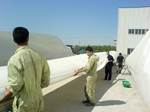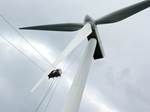Wind blade repair: Safety and quality
Perhaps the biggest challenges to safely repairing a damaged wind blade in the field are wind and weather. “High winds will prevent technicians from getting up on the blade to make the repair, and cold weather will impact the composites and their ability to cure,” explains Peter Wells, the business leader for the Blade Services team at Medford, Ore.-based UpWind Blade Solutions.
Perhaps the biggest challenges to safely repairing a damaged wind blade in the field are wind and weather. “High winds will prevent technicians from getting up on the blade to make the repair, and cold weather will impact the composites and their ability to cure,” explains Peter Wells, the business leader for the Blade Services team at Medford, Ore.-based UpWind Blade Solutions. Wells adds that when planning inspections and repairs, the process always begins with safety and quality.
Safety standards set by wind farm operators establish when workers are allowed to be on the turbine and when the turbine may be locked for blade maintenance. Wind limits range from 10m/sec to 15m/sec (33 ft/sec to 49 ft/sec), says Josh Crayton, the blade services manager for Santa Cruz, Calif.-based wind turbine maintenance firm Rope Partner Inc. The safest place for blade repair is on the ground. Occasionally, work is done inside the blade, which requires a fully confined space procedure to be approved prior to work. For up-tower repair, there are several means of access, including crane-hoisted baskets. UpWind and Wind Energy Services (Gainesville, Texas) use sky platforms anchored to the turbine, but Rope Partner relies on rope access during which repair technicians (generally in teams of two) lower themselves from the turbine via ropes to allow 360° access to the tower, nacelle and blades. Separate bearing ropes and hauling systems can be used to lift heavier equipment, tools and materials. (Many of Rope Partner’s technicians also are recreational climbers.)
Rope Partners claims rope access allows greater flexibility in higher winds, and it is an economical option for up-close inspections. According to Crayton, his teams can work up to the limits set by owners. “Most of the repairs we do are smaller, yet urgent repairs,” he says.
Whether or not large repairs should be conducted up-tower or on the ground depends on the type of damage and its location. “Many of the larger repairs should be do-ne on the ground,” he contends. “Imagine trying to repair major damage to the structural component,” he says, noting that the blade is relying on its tensile (lengthwise) strength, which has been compromised. Wind and the force of gravity could compromise the repair up-tower. “The blade itself weighs 7 tons, and it’s flexed by the force of the wind. Under those conditions, it would be difficult to return the blade to its originally engineered specifications,” he warns.
Related Content
-
Ceramic matrix composites: Faster, cheaper, higher temperature
New players proliferate, increasing CMC materials and manufacturing capacity, novel processes and automation to meet demand for higher part volumes and performance.
-
High-tension, vertical filament winding enables affordable flywheel energy storage system
French startup Energiestro’s prototype solar energy flywheel-based storage system aims to reduce costs with glass fiber composites and prestressed concrete.
-
Achieving composites innovation through collaboration
Stephen Heinz, vice president of R&I for Syensqo delivered an inspirational keynote at SAMPE 2024, highlighting the significant role of composite materials in emerging technologies and encouraging broader collaboration within the manufacturing community.


